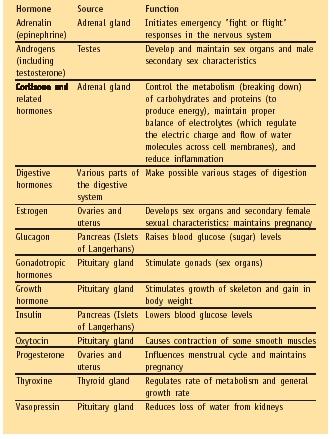Hormones

Hormones are chemicals produced by one kind of tissue in an organism and then transported to other tissues in the organism, where they produce some kind of response. Because of the way they operate, hormones are sometimes called "chemical messengers." Hormones are very different from each other—depending on the functions they perform—and they occur in both plants and animals.
An example of hormone action is the chemical known as vasopressin. Vasopressin is produced in the pituitary gland (at the base of the brain) of animals and then excreted into the bloodstream. The hormone travels to the kidneys, where it causes an increase in water retention. Greater water retention produces, in turn, an increase in blood pressure.
Plant hormones
Some of the earliest research on hormones involved plants. In the 1870s, English naturalist Charles Darwin (1809–1882) and his son Francis (1848–1925) studied the effect of light on plant growth. They discovered that plants tend to grow towards a source of light. They called the process phototropism. The reason for this effect was not discovered for another half century. Then, in the 1920s, Dutch-American botanist Frits Went (1863–1935) discovered the presence of certain compounds that control the growth of plant tips toward light. Went named those compounds auxins. Auxins are formed in the green tips of growing plants, in root tips, and on the shaded side of growing shoots. They alter the rate at which various cells in the plant grow so that it always bends towards the light.
Words to Know
Auxins: A group of plant hormones responsible for patterns of plant growth.
Endocrine glands: Glands that produce and release hormones in an animal.
Phototropism: The tendency of a plant to grow towards a source of light.
Plant growth regulators: Plant hormones that affect the rate at which plants grow.
Many other plant hormones have since been discovered. These hormones are also called plant growth regulators because they affect the rate at which roots, stems, leaves, or other plant parts grow. The gibberellins,
Important Hormones of the Human Body

| Hormone | Source | Function |
| Adrenalin (epinephrine) | Adrenal gland | Initiates emergency "fight or flight" responses in the nervous system |
| Androgens (including testosterone) | Testes | Develop and maintain sex organs and male secondary sex characteristics |
| Cortisone and related hormones | Adrenal gland | Control the metabolism (breaking down) of carbohydrates and proteins (to produce energy), maintain proper balance of electrolytes (which regulate the electric charge and flow of water molecules across cell membranes), and reduce inflammation |
| Digestive hormones | Various parts of the digestive system | Make possible various stages of digestion |
| Estrogen | Ovaries and uterus | Develops sex organs and secondary female sexual characteristics; maintains pregnancy |
| Glucagon | Pancreas (Islets of Langerhans) | Raises blood glucose (sugar) levels |
| Gonadotropic hormones | Pituitary gland | Stimulate gonads (sex organs) |
| Growth hormone | Pituitary gland | Stimulates growth of skeleton and gain in body weight |
| Insulin | Pancreas (Islets of Langerhans) | Lowers blood glucose levels |
| Oxytocin | Pituitary gland | Causes contraction of some smooth muscles |
| Progesterone | Ovaries and uterus | Influences menstrual cycle and maintains pregnancy |
| Thyroxine | Thyroid gland | Regulates rate of metabolism and general growth rate |
| Vasopressin | Pituitary gland | Reduces loss of water from kidneys |
for example, are chemicals that occur in many different kinds of plants. They cause cells to divide (reproduce) more quickly and to grow larger in size. Another group of plant growth regulators is the cytokinins. One interesting effect of the cytokinins is that they tend to prevent leaves from aging. When placed on a yellow leaf, a drop of cytokinin can cause the leaf to turn green again.
Animal hormones
Hundreds of different hormones have been discovered in animals. The human body alone contains more than 100 different hormones. These hormones are secreted by endocrine glands, also known as ductless glands. Examples of endocrine glands include the hypothalamus, pituitary gland, pineal gland, thyroid, parathyroid, thymus, adrenals, pancreas, ovaries, and testes. Hormones are secreted from these glands directly into the bloodstream. They then travel to target tissues and regulate digestion, growth, maturation, reproduction, and homeostasis (maintaining the body's chemical balance).
[ See also Diabetes mellitus ; Endocrine system ; Reproductive system ; Stress ]